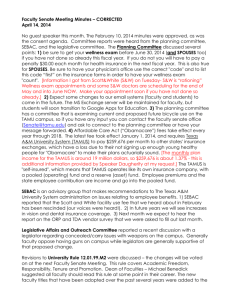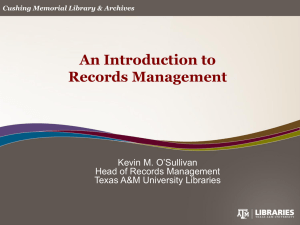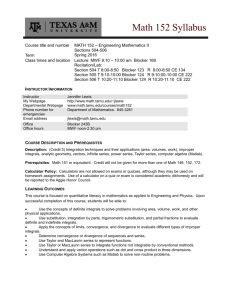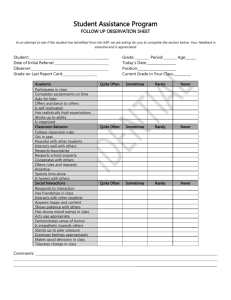Depth Vs. Duration PBL
advertisement
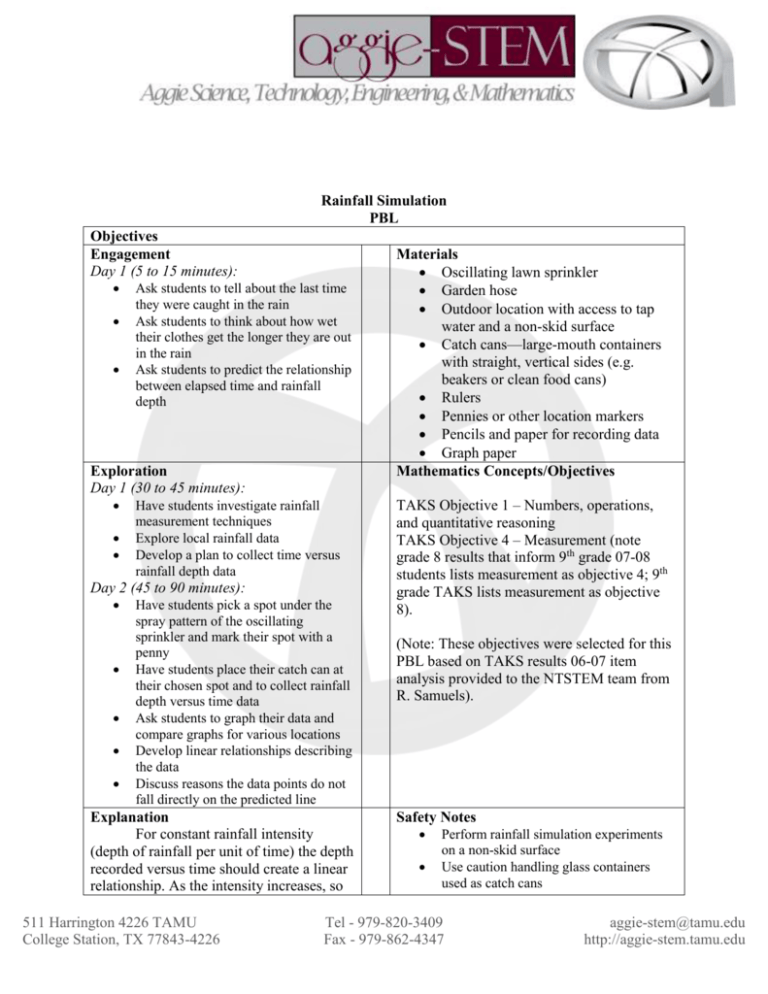
Rainfall Simulation PBL Objectives Engagement Day 1 (5 to 15 minutes): Ask students to tell about the last time they were caught in the rain Ask students to think about how wet their clothes get the longer they are out in the rain Ask students to predict the relationship between elapsed time and rainfall depth Exploration Day 1 (30 to 45 minutes): Have students investigate rainfall measurement techniques Explore local rainfall data Develop a plan to collect time versus rainfall depth data Day 2 (45 to 90 minutes): Have students pick a spot under the spray pattern of the oscillating sprinkler and mark their spot with a penny Have students place their catch can at their chosen spot and to collect rainfall depth versus time data Ask students to graph their data and compare graphs for various locations Develop linear relationships describing the data Discuss reasons the data points do not fall directly on the predicted line Explanation For constant rainfall intensity (depth of rainfall per unit of time) the depth recorded versus time should create a linear relationship. As the intensity increases, so 511 Harrington 4226 TAMU College Station, TX 77843-4226 Materials Oscillating lawn sprinkler Garden hose Outdoor location with access to tap water and a non-skid surface Catch cans—large-mouth containers with straight, vertical sides (e.g. beakers or clean food cans) Rulers Pennies or other location markers Pencils and paper for recording data Graph paper Mathematics Concepts/Objectives TAKS Objective 1 – Numbers, operations, and quantitative reasoning TAKS Objective 4 – Measurement (note grade 8 results that inform 9th grade 07-08 students lists measurement as objective 4; 9th grade TAKS lists measurement as objective 8). (Note: These objectives were selected for this PBL based on TAKS results 06-07 item analysis provided to the NTSTEM team from R. Samuels). Safety Notes Perform rainfall simulation experiments on a non-skid surface Use caution handling glass containers used as catch cans Tel - 979-820-3409 Fax - 979-862-4347 aggie-stem@tamu.edu http://aggie-stem.tamu.edu does the slope of the time-depth relationship. Data collected, however, will show variability. Both natural rainfall and simulated rainfall generated by irrigation systems vary by location. Natural rainfall varies by location because of differences in intensity associated with cloud variability and movement. Irrigation varies spatially because of the spray pattern associated with equipment and environmental factors such as wind direction and speed. Large irrigation systems such as those used in public parks or agricultural fields are designed by engineers to minimize this variability. Extension 1 Influence of Intensity Vary the “intensity” of the simulated rainfall by changing the water pressure delivered to the sprinkler. How does this change the depth versus time relationship? Extension 2 Estimate Water Volume Rainfall volume can be estimated as depth times area. Have students measure the area wetted by the sprinkler and use this information with their depth data to estimate volume of water delivered by the sprinkler. Evaluation PBL Rubrics Teacher-created TAKS formatted questions related to high stakes objectives/TEKS-TAKS presentation TI Navigator – technology demonstrating teacher formatted questions as application for classroom immediate assessment 511 Harrington 4226 TAMU College Station, TX 77843-4226 Use caution handling the cut edge of cleaned food cans used as catch cans Use caution around the trip hazard caused by the extended garden hose Website: Access the powerpoint for this lesson plan at ntstem.tamu.edu Tel - 979-820-3409 Fax - 979-862-4347 aggie-stem@tamu.edu http://aggie-stem.tamu.edu Social Interaction Rubric CATEGORY Communication Advanced Proficient Basic Minimal Routinely communicates useful ideas. Rarely dominates discussion. Usually communicates useful ideas. Occasionally dominates discussion. Usually appears to listen attentively to other group members through eye contact and body language. Occasionally interrupts others. Usually is publicly positive of the project and the work of others. Usually has a positive attitude toward the project and others. Usually draws on other group members’ ideas when participating. Usually addresses others’ ideas and responds accordingly. Usually gives explanations of communication with clear reasoning and logical thought processes. Usually speaks coherently and cohesively. Sometimes communicates useful ideas. Often dominates discussion. Rarely provides useful ideas. Always tries to dominate discussion or not engaged in discussion enough to dominate. Rarely appears to listen attentively to other group members through eye contact and body language. Always tries to interrupt others or does not listen enough to engage at all. Rarely is publicly positive of the project and the work of others. Rarely has a positive attitude toward the project and others. Listening Routinely appears to listen attentively to other group members through eye contact and body language. Rarely interrupts others. Attitude Routinely is publicly positive of the project and the work of others. Often has a positive attitude toward the project and others. Routinely draws on other group members’ ideas when participating. Often addresses others’ ideas and responds accordingly. Consideration Explanation Routinely gives explanations of communication with clear reasoning and logical thought processes. Speaks coherently and cohesively. 511 Harrington 4226 TAMU College Station, TX 77843-4226 Tel - 979-820-3409 Fax - 979-862-4347 Sometimes appears to listen attentively to other group members through eye contact and body language. Often interrupts others. Sometimes is publicly positive of the project and the work of others. Sometimes has a positive attitude toward the project and others. Sometimes draws on other group members’ ideas when participating. Sometimes addresses others’ ideas and responds accordingly. Sometimes gives explanations of communication with clear reasoning and logical thought processes. Sometimes speaks coherently and cohesively. Rarely draws on other group members’ ideas when participating. Rarely addresses others ideas and responds accordingly. Often tries to work alone. Rarely gives explanations of communication with clear reasoning and logical thought processes. Rarely speaks coherently and cohesively. Communication often seems disconnected. aggie-stem@tamu.edu http://aggie-stem.tamu.edu Individual Accountability Rubric CATEGORY Preparedness Advanced Proficient Basic I routinely bring needed materials. I am always ready to work. I usually bring needed materials. I am usually ready to work. I sometimes bring needed materials. I am sometimes ready to work. I rarely bring needed materials. I am rarely ready to work. Focus I routinely stay focused on tasks that need to get done. I routinely use my time well. The group does not have to adjust deadlines or responsibilities due to my participation. I routinely produce work of the highest quality. I routinely produce work that shows my best effort. Collaboration I routinely listen, share, and support the efforts of others. I routinely keep people working together well. I usually listen, share, and support the efforts of others. I do not cause tension in the group. I sometimes stay focused on tasks that need to get done. I sometimes use my time well. The group has had to adjust deadlines or responsibilities twice due to my participation. I sometimes produce work that has to be checked or redone by other group members to ensure quality. I usually produce work that shows some effort. I sometimes listen, share, and support the efforts of others. Occasionally, I do not work well with the group. I rarely stay focused on the tasks that need to get done. I rarely use my time well. The group has had to adjust deadlines or responsibilities three or more times due to my participation. Quality I usually stay focused on tasks that need to get done. I usually use my time well. The group has had to adjust deadlines or responsibilities once due to my participation. I usually produce work of high quality. I usually produce work that shows strong effort. Problem-solving I routinely look for and suggest solutions to problems. I usually look for and suggest solutions to problems. However, most of the time, I refine solutions suggested by others. I sometimes look for and suggest solutions to problems as well as try to refine the solutions of others. However, most of the time, I simply go along with the solutions of others. I rarely look for and suggest solutions to problems or try to refine the solutions of others. In fact, most of the time, I let others do the work. 511 Harrington 4226 TAMU College Station, TX 77843-4226 Tel - 979-820-3409 Fax - 979-862-4347 Minimal I usually produce work that has to be checked or redone by other group members to ensure quality. I usually produce work that shows very little effort. I rarely listen, share, and support the efforts of others. I often do not work well with the group. aggie-stem@tamu.edu http://aggie-stem.tamu.edu Mathematics/Science Rubric CATEGORY Knowledge and Understanding Reasoning Communication 8-7 Demonstrates complete understanding of the concepts and principles. Is able to apply knowledge to challenging problems in unfamiliar situations. Executes algorithms completely and in a correct manner. Identifies the elements of the problem and shows understanding of the relationship between them. Selects and applies problemsolving techniques to recognize patterns. Draws conclusions consistent with findings. Provides justifications or proofs were appropriate. Successfully follows correct mathematical and scientific notation. Moves effectively between different forms of mathematical representation. Reasoning is concise, logical, and complete. Supports his findings by effective use of diagrams, charts, and other visual tools. 511 Harrington 4226 TAMU College Station, TX 77843-4226 6-5 4-3 2-1 0 Demonstrates nearly complete understanding of the problem’s concepts and principles. Is able to apply knowledge to challenging problems in familiar situations. Executes algorithms completely, but computations may contain minor mistakes. Identifies the important elements of the problem and shows general understanding of the relationship between them. Selects and applies problem-solving techniques to recognize patterns. Draws conclusions consistent with findings. Fails to provide justifications. Demonstrates understanding of some of the problem’s concepts and principles. Is able to apply knowledge to simple, familiar problems. Executes algorithms with some mistakes, and computations contain major errors. Identifies some important elements of the problem and shows general understanding of the relationship between them. Selects and applies problem-solving techniques to recognize patterns. Demonstrates very limited understanding of the problem’s concepts and principles. Is not able but still attempts to solve simple, familiar problems. Executes algorithms with major mistakes, and computations contain serious errors. Identifies only the unimportant elements of the problem and shows very limited understanding of the relationship between them. Applies, with guidance, mathematical problem-solving techniques to recognize patterns. Does not understand the problem. Does not solve the problem. Does not execute algorithms or computations. Follows nearly correct mathematical and scientific notation. Moves between different forms of mathematical representation with some success. Reasoning is clear, but not always logical or complete. Supports findings by using some visual tools. Follows mathematical and scientific notation with some errors. Shows good use of mathematical language and/or forms of mathematical representation, but unable to move between them. Reasoning is not clear. Attempts to follow mathematical and scientific notation. Shows basic use of mathematical language and/or forms of mathematical representation. Reasoning is difficult to follow. Tel - 979-820-3409 Fax - 979-862-4347 aggie-stem@tamu.edu http://aggie-stem.tamu.edu Does not identify elements of the problem and does not understand relationships between them. Does not apply mathematical problem-solving techniques. Does not recognize patterns. Does not follow mathematical and scientific notation. Does not use mathematical language or representation. Reasoning does not exist. 511 Harrington 4226 TAMU College Station, TX 77843-4226 Tel - 979-820-3409 Fax - 979-862-4347 aggie-stem@tamu.edu http://aggie-stem.tamu.edu

